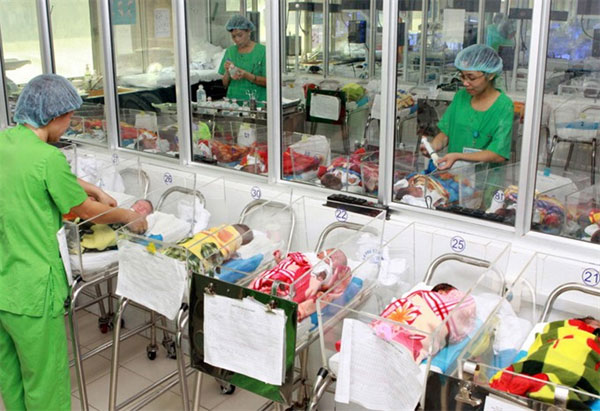[ad_1]
VietNamNet Bridge – Over the last 10 years, Vietnam has been able to stabilise its population growth, and authorities have shifted their focus to population quality.
 |
|
Nurses care for newborns at the National Hospital of Obstetrics and Gynaecology in Hanoi. — VNA/VNS Photo Duong Ngoc
|
The aim now is to ensure that succeeding generations of citizens are healthy by ensuring adequate care for the mother and child before and after birth.
Thus, the theme of the National Population Day, which fell yesterday, was: “Prenatal screening and treatment help improve population quality.”
As part of this, December has been an “action month” to encourage and provide prenatal tests for expecting mothers.
It is targeted that by 2030, 70 per cent of pregnant women are tested for four common infant diseases, and 90 per cent of newborns are screened for five commonly occurring diseases.
Early detection
About a month ago, Do Thi Hanh, a mother in Cai Be District in the southern province Tien Giang, brought her two-year-old son to the hospital with convulsions and learnt that he was afflicted with epilepsy. Previously, Hanh had only noticed that her son’s head circumference was slightly smaller than other children.
Doctors said that microcephaly – and therefore, possible risks of associated symptoms such as epilepsy, impaired cognitive and motor functions, or dwarfism – can be easily identified by x-ray imaging during pregnancy.
Specifically, an x-ray is recommended for each week during the first 16 weeks of pregnancy, and once every two weeks in the next 28 weeks.
In another case, Huynh Thi Lan Anh, a mother in HCM City was lucky that abnormalities were spotted in her child right after giving birth and timely interventions made.
“Thanks to the heel prick test for newborns, my child was found to suffer from enzyme glucose-6-phosphate dehydrogenase (G6PD) deficiency (enzyme that helps red blood cells to function normally). Doctors and medical staff guided me in following a medicine regime and proper diet and so far, for the last seven years, my daughter has been healthy,” Lan Anh said.
If the abnormalities are not spotted early, before or immediately after birth, the unfortunate children end up being a burden to the family and society at large.
A lot of this can be avoided because modern medicine has made significant headway in being able to discover more and more latent diseases during pregnancy or soon after birth, allowing for early interventions and cures.
Nguyen Manh Tri, deputy head of Ha Noi Obstetrics and Gynaecology Hospital, told the Voice of Vietnam that latest technology combined with routine screenings and tests would allow for successful detection of 80-90 per cent of all foetal abnormalities.
The hospital divides infant illnesses into three groups. The first group concerns genetic diseases, which could mean that little to nothing can be done. The second group comprises physical deformities, such as cleft lip and palates, which can be repaired after birth. The third group covers functional abnormalities, the level of which is hard to determine during pregnancy, hard to get a proper prognosis of and not easily amenable to treatment, Tri said.
While a national scale comprehensive study of birth defects has not been done, domestic and international research indicate that birth defects occur in an estimated 1.5-2 per cent of the newborns every year. The frequently diseases are Down syndrome, Ewards syndrome, neural tube defects, adrenal hyperplasia, thalassemia, and other genetic diseases and deformities.
The most common causes of birth defects are determined to be genetic abnormalities, followed by exposure to toxins from the environment during pregnancy, mother’s drug consumption during the first three months of pregnancy, or mothers contracting diseases during pregnancy.
Currently, just 25 per cent of pregnant mothers and 35 per cent of newborns are screened for diseases.
Vietnam’s strategy of providing sexual education and reproductive health services, specifically for adolescents and youth, has been commended by the World Health Organisation (WHO). Most major health centres in the country can screen for 33 human function-related diseases, but these are concentrated in major urban areas like Hanoi, HCM City, Hue, Can Tho, and Nghe An, leaving significant room for improvements in the remote and less populated areas where the majority of residents are ethnic minority communities.
Despite encouraging improvements, several maternal and childcare issues still persist, including the gender imbalance, the rate of malnourishment and stunted newborns, as well as maternal mortality rate, said Deputy Health Minister Nguyen Viet Tien.
Source: VNS
| related news |
[ad_2]
Source link
